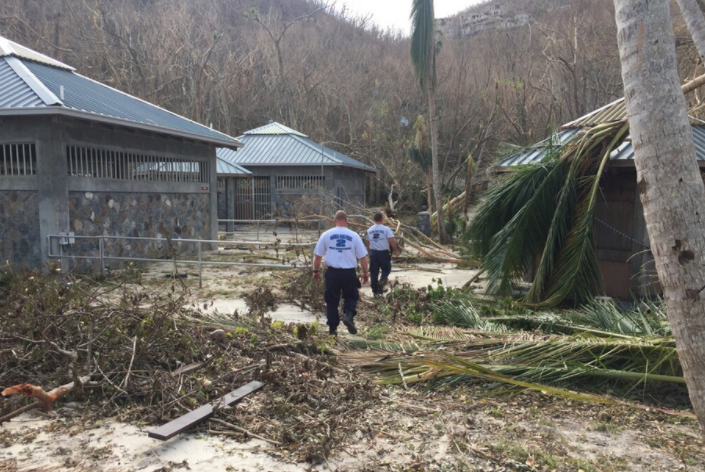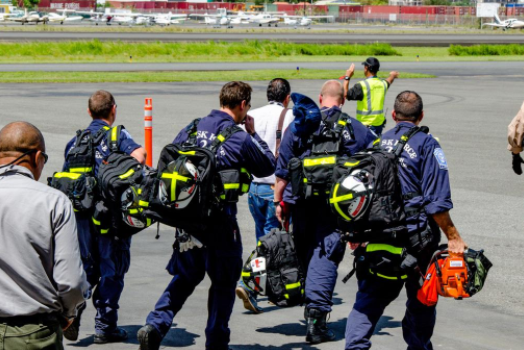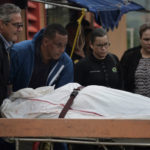CHRISTIANSTED – Roads have been cleared of debris. Electricity is flowing. Stores are open. Students are in school.
Six months after hurricanes Irma and Maria devastated St. Thomas, St. John and St. Croix, recovery is well underway, led by the Virgin Islands Territorial Emergency Management Agency (VITEMA) and local officials with support from the Federal Emergency Management Agency (FEMA) and its partner agencies.
“The residents of these islands are strong,” said Federal Coordinating Officer William Vogel. “They withstood two Category 5 hurricanes in two weeks. They’re working hard to get life back to normal. We are doing all we can to help the territory recover and become better able to face future storms.”
Hurricane Irma struck on Sept. 6 and Maria struck Sept. 19. After the second storm, more than 100,000 residents lost power. A joint effort by the Virgin Islands Water and Power Authority, FEMA, Haugland Energy and other power companies restored power to 90 percent of eligible customers within 100 days. This week, 99 percent have power.
As of March 2, 870,726 cubic yards of storm debris has been collected by the U.S. Army Corps of Engineers and territorial agencies. The U.S. Coast Guard oversaw the pollution mitigation and removal of 479 displaced vessels.
Federal agencies have provided more than $800 million to the territory in FEMA grants, disaster loans by the U.S. Small Business Administration and claims payments by the National Flood Insurance Program.
The territory still faces many challenges.
Blue tarps remain on many roofs. The territory has initiated the Emergency Home Repairs VI program, funded by FEMA Public Assistance, to make emergency repairs to homes so they are safe and habitable for sheltering. FEMA Individual Assistance is providing money for repairs to eligible households and has activated a program to provide direct repairs to eligible households.
Hospitals are heavily damaged. A joint task force is conducting a detailed assessment of medical facilities, including Juan Luis Hospital, Schneider Hospital and the Myrah Keating Smith Community Health Center. This is an important step in determining the cost to repair or replace these facilities. In the meantime, FEMA, the U.S. Army Corps of Engineers and the U.S. Department of Health and Human Services are working to provide temporary medical facilities so people don’t have to travel to the mainland for treatment of critical care conditions.
In St. Croix, a three-suite operating room is scheduled to be installed in parking lots at Juan Luis Hospital in late May. The hospital has requested proposals to construct a temporary dialysis treatment facility at Juan Luis Hospital. A temporary medical facility is planned for the Virgin Islands Department of Health clinic at the Charles Harwood Medical Complex site by late June. In St. Thomas, a temporary medical facility is planned for Schneider Hospital by late June. In St. John, the Army Corps estimates completion of a temporary patient care clinic at Myrah Keating Smith Community Health Center by late May.
Thirteen schools were closed after the storms and students have been attending other schools on double shifts. The Virgin Islands Department of Education has identified 24 storm-damaged properties on St. Croix; 18 are schools and the remaining six include the curriculum center, headquarters, adult education center, procurement warehouse, youth rehabilitation center and school lunch warehouse. On St. Thomas and St. John, the Department of Education has identified 23 storm-damaged properties; 20 are schools and the remaining three are the curriculum center, headquarters and school lunch warehouse. FEMA is working with VITEMA and the Department of Education to assess requirements for temporary facilities for schools that have been damaged.
“FEMA will stay on the job until the job is done,” Vogel said. “Voluntary organizations are working hard to help those affected by the storms. Long-term recovery groups have formed. These communities are on the road to recovery.”
By the Numbers (March 2, 2018)
- FEMA Individuals and Households:$71.8 million
- Housing Assistance: $50.1 million
- Other Needs Assistance: $21.7 million
- FEMA Public Assistance: $261.9 million
- U.S. Small Business Administration: $459.8 million
- National Flood Insurance Program: $6.6 million
- Federal staff currently deployed: 497
- Disaster Recovery Center visits: 65,372
- Medical patients/caregivers evacuated (USVI/Puerto Rico): 781 cumulative, 246 currently
- Emergency prescription assistance: $648,131
- Power restoration to eligible customers: 99 percent
- Debris removal: 870,726 cubic yards
- Generators installed: 180 cumulative; 13 currently
- Disaster unemployment assistance: 1,208 applicants approved, $2.1 million
- Disaster case management: $11.5 million
- Crisis counseling: $2.5 million
- Chemical containers removed: 3,668
- Gallons of fuel/oil recovered: 12,449
- Hazardous waste collected:
- Small containers: 62,614
- Containers (6-54 gal): 290
- Drums: 192
- Propane tanks: 1,525
- Fire extinguishers: 784
- Cylinders: 769
- Batteries: 14,464
- Fluorescent bulbs: 24,105
- Electronic waste pallets (St. Thomas/St. John): 368
- Electronic waste items (St. Croix): 42,881
- White goods: 5,181
- Sharps containers: 3,802
- Bags of medical waste: 5,950
- Pounds of refrigerant: 69
Disaster recovery assistance is available without regard to race, color, religion, nationality, sex, age, disability, English proficiency or economic status. If you or someone you know has been discriminated against, call FEMA toll-free at 800-621-3362 (voice, 711/VRS – Video Relay Service)
(TTY: 800-462-7585). Multilingual operators are available (press 2 for Spanish).
FEMA’s mission is to support our citizens and first responders to ensure that as a nation we work together to build, sustain, and improve our capability to prepare for, protect against, respond to, recover from, and mitigate all hazards
Following major disasters, the U. S. Small Business Administration (SBA) is the primary source of Federal funds for long-term recovery assistance. This assistance is in the form of low-interest loans and is available to non-farm businesses of all sizes, private nonprofit organizations, as well as homeowners and renters with property damaged by the disaster.
Follow us on social media at twitter.com/femaregion2 and www.facebook.com/FEMAUSVirginIslands.
To donate or volunteer, contact the voluntary or charitable organization of your choice through the National Voluntary Organizations Active in Disaster (NVOAD) at www.nvoad.org. For those who wish to help, cash donations offer voluntary agencies the most flexibility in obtaining the most-needed resources and pumps money into the local economy to help businesses recover. The Community Foundation of the Virgin Islands also has the “Fund for the Virgin Islands” at www.USVIrecovery.org.




